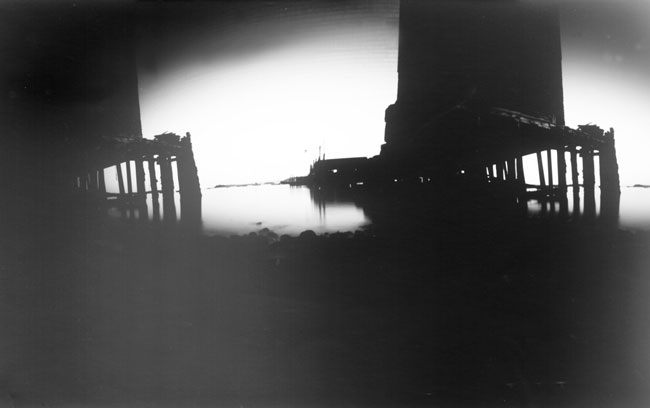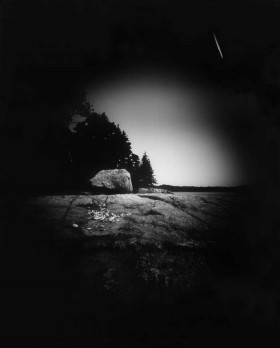
Anne-Claude Cotty, Stonington Piers, pinhole photograph
Make a pinhole camera using a box from the kitchen shelf and take beautiful soft-focus photographs in the Make a Pinhole Camera workshops offered at Penobscot Marine Museum this summer. A pinhole camera is a camera without a lens and with a single small aperture, a pinhole. Light from a scene passes through this single point and projects an inverted image on the opposite side of the box where a piece of film or photographic paper is wedged or taped into the other end. The ethereal images made with a pinhole camera seem magical. Workshop teacher Anne-Claude Cotty is a photographer, artist and teacher living in Stonington, Maine. She has taught at Haystack Mountain School of Crafts, and her work has been exhibited at the University of Maine Museum of Art, Colby College Art Museum, and the Portland Museum of Art.

Anne-Claude Cotty, Islands by Kayak, pinhole photograph
There are two opportunities to take the Make a Pinhole Camera workshop at Penobscot Marine Museum this summer: Thursday, July 23, 1:00 to 4:00 pm and Thursday, August 6, 1:00 to 4:00 pm. The cost is $10 per person, $7 for Museum members. Make a Pinhole Camera is open to all ages, but young children must be accompanied by an adult. For more information or to buy tickets call 207-548-0334 or click here.
Make a Pinhole Camera is part of Exploring the Magic of Photography: Painting with Light,Penobscot Marine Museum’s first major exhibition of historic photography. It includes four exhibits, a walk-in camera, a wall of selfies taken by museum visitors, an historic darkroom, tintype and cyanotype demonstrations, and workshops on making pin-hole cameras. The four exhibits, Through Her Lens: Women Photographers of Mid-Coast Maine, 1890-1920; Twenty Best; Evolution of the Photographic Snapshot: 1888-2015; and The Carters and the Lukes – Selections from the Red Boutilier Collection are filled with inter-active opportunities for visitors including life-sized photographic cut-outs with which visitors may photograph themselves, an online exhibit of visitor photographs and comments, and QR codes and tablets providing access to audio clips of interviews, biographies, and commentary by historians, curators and professional photographers.
